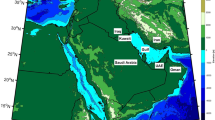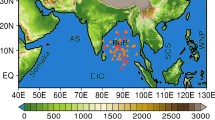Abstract
This study applied eigenvector-based time-decomposition and spatial-decomposition techniques to examine mechanisms through which the positive Indian Ocean Dipole (IOD) sea surface temperature (SST) pattern can influence the patterns of summer rainfall over southern Africa. For the time-decomposition analysis, it was found that over the eastern subcontinent of Africa, south of the equator, positive IOD can induce a meridional dipole rainfall structure through a circulation-type (CT) that its variability can be directly independent of the El Niño Southern Oscillation. Spatial decomposition of austral summer rainfall anomalies also detects a dipole-like pattern of austral summer homogeneous region of rainfall anomaly over the eastern subcontinent of Africa, south of the equator, which can be triggered by the IOD in a delay of about 5 months (with the IOD signal leading). Thus, the signature of the atmospheric signal associated with the SST pattern of the IOD can persist into austral summer and modify austral summer circulation patterns. The large-scale circulation mechanisms through which the positive IOD triggers the meridional rainfall structure are: (i) strengthening of the pressure gradient between the northern and southern domains of the Mozambique Channel and (ii) enhancement of the amplitude of the CT associated with enhanced convergence and convection (i.e., cyclonic circulation) north of Mozambique Channel; thus, disrupting onshore moisture transport from the southwest Indian Ocean into the southeastern subcontinent of Africa where divergence and anticyclonic activity rather dominates. The resulting rainfall pattern is that the northeastern (southeastern) regions are wetter (drier) than normal. Under the shared socio-economic pathway highest emission scenario (ssp585), overall, the analysed climate models indicated that the relative frequency of occurrence of the CT related to the positive IOD is projected to increase during the January and March months.








Similar content being viewed by others
References
Barimalala R, Blamex R C, Desbiolles F and Reason C J C 2020 Variability in the Mozambique Channel trough and impacts on southeast African rainfall; J. Clim. 33 749–765, https://doi.org/10.1175/JCLI-D-19-0267.1.
Barreira S and Compagnucci R 2011 Spatial fields of Antarctic sea-ice concentration anomalies for summer – Autumn and their relationship to Southern Hemisphere atmospheric circulation during the period 1979–2009; Ann. Glaciol. 52 140–150, https://doi.org/10.3189/172756411795931741.
Behera S K, Krishnan R and Yamagata T 1999 Unusual ocean–atmosphere conditions in the tropical Indian Ocean during 1994; Geophys. Res. Lett. 26 3001–3004, https://doi.org/10.1029/1999GL010434.
Behera S K, Rao S A, Saji H N and Yamagata T 2003 Comments on “A cautionary note on the interpretation of EOFs”; J. Clim. 16 1087–1093, https://doi.org/10.1175/1520-0442(2003)016<1087:COACNO>2.0.CO;2.
Cai W, Zheng X-T, Weller E, Collins M, Cowan T, Lengaigne M, Yu W and Yamagata T 2013 Projected response of the Indian Ocean Dipole to greenhouse warming; Nat. Geosci. 6 999–1007, https://doi.org/10.1038/ngeo2009.
Compagnucci R H and Richman M B 2008 Can principal component analysis provide atmospheric circulation or teleconnection patterns?; Int. J. Climatol. 28 703–726, https://doi.org/10.1002/joc.1574.
Cook K H 2000 The South Indian Convergence Zone and interannual rainfall variability over southern Africa; J. Clim. 13 3789–3804, https://doi.org/10.1175/1520-0442(2000)013<3789:TSICZA>2.0.CO;2.
Eyring V, Bony S, Meehl G A, Senior C A, Stevens B, Stouffer R J and Taylor K E 2016 Overview of the Coupled Model Intercomparison Project Phase 6 (CMIP6) experimental design and organisation; Geosci. Model Dev. 9 1937–1958, https://doi.org/10.5194/gmd-9-1937-2016.
Feng J, Hu D and Yu L 2014 How does the Indian Ocean subtropical dipole trigger the tropical Indian Ocean dipole via the Mascarene high?; Acta. Oceanol. Sin. 33 64–76, https://doi.org/10.1007/s13131-014-0425-6.
Hendrickson A E and White P O 1964 Promax: A quick method to oblique simple structure; Br. J. Stat. Psychol. 17 65.
Hersbach H, Bell B, Berrisford P, Hirahara S, Nicolas J, Radu R, Simmons A, Abellan X, Soci C, Bechtold P et al. 2020 The ERA5 global reanalysis; Quart. J. Roy. Meteorol. Soc. 146 1999–2049, https://doi.org/10.1002/qj.3803.
Hoell A, Funk C, Zinke J et al. 2017 Modulation of the southern Africa precipitation response to the El Niño Southern Oscillation by the subtropical Indian Ocean Dipole; Clim. Dyn. 48 2529–2540, https://doi.org/10.1007/s00382-016-3220-6.
Ibebuchi C C 2021a On the relationship between circulation patterns, the southern annular mode, and rainfall variability in Western Cape; Atmosphere 12 753, https://doi.org/10.3390/atmos12060753.
Ibebuchi C C 2021b Revisiting the 1992 severe drought episode in South Africa: The role of El Niño in the anomalies of atmospheric circulation types in Africa south of the equator; Theor. Appl. Climatol. 146 723–740, https://doi.org/10.1007/s00704-021-03741-7.
Jiang Y, Zhou L, Roundy P E, Hua W and Raghavendra A 2021 Increasing influence of Indian Ocean Dipole on precipitation over Central Equatorial Africa; Geophys. Res. Lett. 48(8).
Kalnay E et al. 1996 The NCEP/NCAR 40-year reanalysis project; Bull. Am. Meteor. Soc. 77 437–472, https://doi.org/10.1175/1520-0477(1996)077<0437:TNYRP>2.0.CO;2.
Kuleshov Y, Qi L, Fawcett R and Jones D 2008 On tropical activity in the Southern Hemisphere: Trends and the ENSO connection; Geophys. Res. Lett. 35 L14S08, https://doi.org/10.1029/2007GL032983.
Lazenby M J, Todd M C and Wang Y 2016 Climate model simulation of the South Indian Ocean Convergence Zone: Mean state and variability; Clim. Res. 68 59–71, https://doi.org/10.3354/cr01382.
Li T, Wang B, Chang C P and Zhang Y 2003 A theory for the Indian Ocean dipole–zonal mode; J. Atmos. Sci. 60 2119–2135, https://doi.org/10.1175/1520-0469(2003)060<2119:ATFTIO>2.0.CO;2.
Lim E P and Hendon H H 2017 Causes and predictability of the negative Indian Ocean Dipole and its impact on La Niña during 2016; Sci. Rep. 7 602, https://doi.org/10.1038/s41598-017-12674-z.
Manatsa D 2021 Drought looms over southern Africa, https://www.herald.co.zw/drought-looms-over-southern-africa/.
Manatsa D, Chingombe W and Matarira C H 2008 The impact of the positive Indian Ocean dipole on Zimbabwe droughts; Int. J. Clim. 28 2011–2029, https://doi.org/10.1002/joc.1695.
Manatsa D, Matarira C H and Mukwada G 2011 Relative impacts of ENSO and Indian Ocean dipole/zonal mode on east SADC rainfall; Int. J. Climatol. 31 558–577, https://doi.org/10.1002/joc.2086.
Manatsa D, Chipindu B and Behera S 2012 Shifts in IOD and their impacts on association with East Africa rainfall; Theor. Appl. Climatol. 110 115–128, https://doi.org/10.1007/s00704-012-0610-5.
Montroy D L, Richman M B and Lamb P J 1998 Observed non-linearities of monthly teleconnections between tropical Pacific sea-surface temperature anomalies and central and eastern North American precipitation; J. Clim. 11 812–835.
Munday C and Washington R 2017 Circulation controls on Southern Africa precipitation in coupled models: The role of the Angola low; J. Geophys. Res. Atmos. 122 861–877, https://doi.org/10.1002/2016JD025736.
Murtugudde R G, McCreary J P and Busalacchi A J 2000 Oceanic processes associated with anomalous events in the Indian Ocean with relevance to 1997–1998; J. Geophys. Res. 105 3295–3306, https://doi.org/10.1029/1999JC900294.
Pascale S, Pohl B, Kapnick S and Zhang H 2019 On the Angola low interannual variability and its role in modulating ENSO effects in southern Africa; J. Clim. 32 4783–4803, https://doi.org/10.1175/JCLI-D-18-0745.1.
Rao S A and Yamagata T 2004 Abrupt termination of Indian Ocean dipole events in response to intraseasonal disturbances; Geophys. Res. Lett. 31 L19306, https://doi.org/10.1029/2004GL020842.
Reason C J C and Smart S 2015 Tropical Southeast Atlantic warm events and associated rainfall anomalies over Southern Africa; Front. Environ. Sci. 3 24, https://doi.org/10.3389/fenvs.2015.00024.
Richman M B 1981 Obliquely rotated principal components: An improved meteorological map typing technique?; J. Appl. Meteorol. 20 1145–1159, https://doi.org/10.1175/1520-0450(1981)020<1145:ORPCAI>2.0.CO;2.
Richman M B 1986 Rotation of principal components; J. Clim. 6 293–335, https://doi.org/10.1002/joc.3370060305.
Richman M B and Gong X F 1999 Relationships between the definition of the hyperplane width to the fidelity of principal component loading patterns; J. Clim. 645 1557–1576, https://doi.org/10.1175/15200442(1999)012<1557:RBTDOT>2.0.CO;2.
Richman M B and Lamb P J 1985 Climatic pattern analysis of three and seven-day summer rainfall in the Central United States: Some methodological considerations and regionalisation; J. Clim. Appl. Meteorol. 24 1325–1343, https://doi.org/10.1175/15200450(1985)024<1325:CPAOTA>2.0.CO;2.
Roxy M, Gualdi S, Drbohlav H-K L and Navarra A 2011 Seasonality in the relationship between El Niño and Indian Ocean dipole; Clim. Dyn. 37 221–236, https://doi.org/10.1007/s00382-010-0876-1.
Roxy M K, Ritika K, Terray P and Masson S 2014 The curious case of Indian Ocean warming; J. Clim. 27 8501–8509, https://doi.org/10.1175/JCLI-D-14-00471.1.
Saji N H and Yamagata T 2003 Possible impacts of Indian Ocean Dipole mode events on global climate; Clim. Res. 25 151–169, https://www.jstor.org/stable/24868393.
Saji N H, Goswami B N, Vinayachandran P N and Yamagata T 1999 A dipole mode in the tropical Indian Ocean; Nature 401 360–363, https://doi.org/10.1038/43854.
Tyson P D 1986 Climatic change and variability in Southern Africa; Oxford University Press, Capetown.
Vigaud N, Richard Y, Rouault M and Fauchereau N 2009 Moisture transport between the South Atlantic Ocean and Southern Africa: Relationships with summer rainfall and associated dynamics; Clim. Dyn. 32 113–123, https://doi.org/10.1007/s00382-008-0377-7.
Walker G 1904 Walker: Identifying the Southern Oscillation; https://iridl.ldeo.columbia.edu/maproom/ENSO/New/walker.html.
Webster P J, Moore A M, Loschnigg J P and Leben R R 1999 Coupled ocean–atmosphere dynamics in the Indian Ocean during 1997–98; Nature 401 356–360, https://doi.org/10.1038/43848.
Xie P, Chen M, Yang S, Yatagai A, Hayasaka T, Fukushima Y and Liu C 2007 A gauge-based analysis of daily precipitation over East Asia; J. Hydrometeorol. 8 607–626, https://doi.org/10.1175/JHM583.1.
Yuan D, Zhou H and Zhao X 2013 Interannual climate variability over the Tropical Pacific Ocean induced by the Indian Ocean Dipole through the Indonesian throughflow; J. Clim. 26 2845–2861, https://doi.org/10.1175/JCLI-D-12-00117.1.
Zubair L, Rao S A and Yamagata T 2003 Modulation of Sri Lankan Maha rainfall by the Indian Ocean Dipole; Geophys. Res. Lett. 30 1063, https://doi.org/10.1029/2002GL015639.
Acknowledgements
Author wishes to thank the Copernicus Climate Change Service and NOAA/OAR/ESRL PSL for providing the ERA5 and NCEP-NCAR reanalysis data sets, respectively. He also thanks the Climate Prediction Center for making the gridded precipitation data used in this work available. Author acknowledge the World Climate Research Programme’s Working Group on Coupled Modelling, which is responsible for CMIP simulations used in this work. Thanks to the anonymous reviewers for the helpful comments.
Author information
Authors and Affiliations
Contributions
All aspects of the work were designed and executed by Chibuike Ibebuchi.
Corresponding author
Additional information
Communicated by P A Francis
Appendix
Appendix
Classified circulation types in Africa south of the equator from ERA5. Nine PCs or modes of variability were retained. For a given retained mode, days with PC loadings above \(\left|0.2\right|\), the threshold used to define signals are grouped, resulting in two classes. The CTs are the SLP composites of the days grouped in a given class. The CT related to the positive IOD is marked by the thick black frame.
Rights and permissions
About this article
Cite this article
Ibebuchi, C.C. Patterns of atmospheric circulation linking the positive tropical Indian Ocean dipole and southern African rainfall during summer. J Earth Syst Sci 132, 13 (2023). https://doi.org/10.1007/s12040-022-02025-6
Received:
Revised:
Accepted:
Published:
DOI: https://doi.org/10.1007/s12040-022-02025-6






